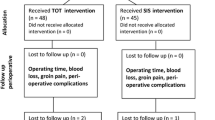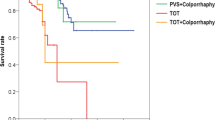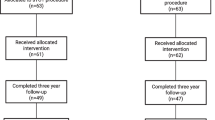Abstract
Introduction and hypothesis
This study aims to analyze comparatively the efficacy and safety of synthetic transobturatory and aponeurotic retropubic slings, in the treatment of stress urinary incontinence (SUI) in women.
Methods
Patients were separated in a randomized way. Twenty-one patients were submitted to the operatory correction by the transobturatory sling technique, whereas 20 patients were operated by the retropubic sling technique. All patients were submitted to complete physical exam and urodynamic test. The “T” test and the Mann–Whitney U test were applied to establish comparisons between the two groups. Patients were followed-up for 12 months.
Results
Healing rate was 90.5% (19/21) and 95% (19/20), respectively after 12 months. The transobturatory group presented lesser complications rate than the retropubic group.
Conclusions
The transobturatory and the aponeurotic slings techniques were equally effective for the treatment of SUI. The transobturatory sling has shown fewer complications and lesser surgical time than the aponeurotic sling technique.
Similar content being viewed by others
References
Thomas TM, Plymat KR, Blannin J et al (1980) Prevalence of urinary incontinence. Br Med J 281:1243–1245
Diokno AC, Brock BM, Brown MB et al (1986) Prevalence of urinary incontinence and other urological symptoms in the noninstitutionalized elderly. J Urol 136(5):1022–1025
Giordano D (1907) In: Twentieth Congress Franc de Chir, Paris.
Mc Guire EJ, Lytton B (1978) Pubovaginal sling procedure for stress incontinence. J Urol 119(1):82–84
Petros P, Ulmsten U (1993) An integral theory and its method for the diagnosis and management of female urinary incontinence. Scand J Urol Nephrol 153:1–93
Delorme E (2001) Transobturator urethral suspension: mini-invasive procedure in the treatment of urinary stress incontinence in women [in French]. Prog Urol 1:1306–1313
Palma PCR, Ricetto CZL, Dambrós M et al (2002) Sling transobturatório: uma nova opção minimamente invasiva para o tratamento da incontinência urinária de esforço. Urodin Uroginecol 5:109–113
Rortveit G, Daltveit AK, Hannestad YS et al (2003) Norwegian EPINCONT Study. Urinary incontinence after vaginal delivery or cesarean section. N Engl J Med 348:900–907
Bezerra CA, Bruschini H (2001) Suburethral sling operations for urinary incontinence in women. Update of: Cochrane Database Syst Rev; 3: CD001754.
Bump RC, Mattiasson A, Bo K, Brubaker LP, DeLancey JOL et al (1996) The standardization of terminology of female pelvic organ prolapse and pelvic floor dysfunction. Am J Obstet Gynecol 175:10–11
Abrams P, Cardozo L, Fall M, Griffiths D, Rosier P, Ulmsten U et al (2002) The standardisation of terminology of lower urinary tract function: report from the Standardisation Sub-Committee of the International Continence Society. Neurourol Urodyn 21:167–178
Kassardjian ZG (2004) Sling procedures for incontinence in women. Brit J Urol 93(5):665–670
Latthe PM, Foon R, Toozs-Hobson P (2007) Transobturator and retropubic tape procedures in stress urinary incontinence: a systematic review and meta-analysis of effectiveness and complications. BJOG 114:522–531
Jarvis GJ (1994) Surgery for genuine stress incontinence. Br J Obstet Gynaecol 101(5):371–374
Haab F, Zimmern PE, Leach GE (1996) Female stress urinary incontinence due to intrinsic sphincteric deficiency: recognition and management. J Urol 156(1):3–17
de Tayrac R, Deffieux X, Droupy S et al (2004) A prospective randomized trial comparing tension-free vaginal tape and transobturator suburethral tape for surgical treatment of stress urinary incontinence. Am J Obstet Gynecol 190(3):602–608
Mellier G, Benayed B, Bretones S et al (2004) Suburethral tape via the obturator route: is the sling transobturator a simplification of the sling retropubic? Int Urogynecol J 15:227–232
Mansoor A et al. (2003) 33rd Annual Meeting of the International Continence Society—Conference Abstract 88.
Ansquer Y, Marcollet A, Yazbeck C, Salomon L, Poncelet C et al (2004) The suburethral sling for female stress urinary incontinence: a retropubic or obturator approach? J Am Assoc Gynecol Laparosc 11(3):353–358
Boccon GL, Grise P, de tayrac R, Costa P, Monneins F et al. (2004) Trans-Obturator Tape (TOT) for the treatment of female stress urinary incontinence: a multicentric prospective study. Program and abstracts of the International Continence Society and IUGA Annual Meeting, Paris, France. Abstract 311
Deval B, Haab F (2006) Management of the complications of the synthetic slings. Curr Opin Urol 16(4):240–243
Mellier G, Moore R, Jacquetin B (2004) A meta-analysis of the intra-operative safety and effectiveness of the transobturator hammock seen in results of two prospective studies in 9 countries with 204 patients. Program and abstracts of the International Continence Society Annual Meeting Aug 25-27, Paris, France. Abstract 113.
Roumeguere T, Quackels T, Bollens R, de Groote A, Zlotta A, Bossche MV et al (2005) Trans-obturator vaginal tape (TOT) for female stress incontinence: one year follow-up in 120 patients. Eur Urol 48(5):805–809
Fisher A, Fink T, Zachmann S, Eickenbusch U (2005) Comparison of retropubic and outside-in transobturator sling systems for the cure of female genuine stress urinary incontinence. Eur Urol 48:799–804
Laurikainen E, Valpas A, Kivela A, Kalliola T, Rinne K, Takala T et al (2007) Retropubic compared with transobturator tape placement in treatment of urinary incontinence: a randomized controlled trial. [Comparative Study—Journal Article. Multicenter Study. Randomized Controlled Trial]. Obstet Gynecol 109(1):4–11
Tcherniakovsky M, Del Roy CA, Paramo GL et al (2006) Surgical Treatment for Stress Urinary Incontinence of Transobturator Approuch: Outcomes with Safyre-t ™. Femina 7(34):477–482
Conflicts of interest
None.
Author information
Authors and Affiliations
Corresponding author
Rights and permissions
About this article
Cite this article
Tcherniakovsky, M., Fernandes, C.E., Bezerra, C.A. et al. Comparative results of two techniques to treat stress urinary incontinence: synthetic transobturator and aponeurotic slings. Int Urogynecol J 20, 961–966 (2009). https://doi.org/10.1007/s00192-009-0880-3
Received:
Accepted:
Published:
Issue Date:
DOI: https://doi.org/10.1007/s00192-009-0880-3




